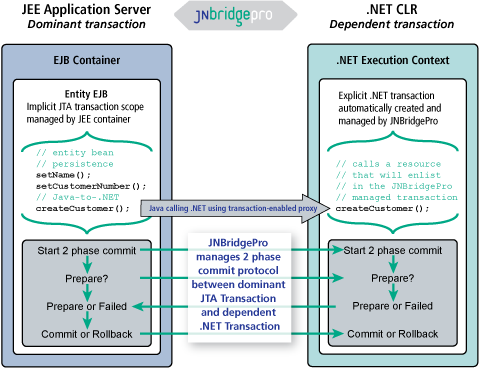Announcing new version of JMS Adapter for .NET
Version 1.2 of the JMS Adapter for .NET supports distributed transactions with full rollback capability
Boulder, Colorado, June 1, 2009 (JavaOne Booth #208)
JNBridge, www.jnbridge.com, the award-winning provider of Java and .NET interoperability tools, today announced the release of version 1.2 of its JMS Adapter for .NET. The adapter provides a single-step integration between JMS (Java Messaging Service) capabilities and .NET Framework-based applications. This new version adds interoperability between .NET distributed transactions and local JMS transactions, thereby allowing JMS to fully participate in .NET transactions.
“We use JNBridge’s core product, JNBridgePro, to rapidly integrate our .NET-based Enterprise Service Bus with our JMS broker,” said Don Taylor, CTO for Benefitfocus. “The ability to combine .NET and JMS transactions will allow us to extend our use of JNBridge interoperability technology to additional business-critical applications where preserving the integrity of data is paramount.”
The JNBridge JMS Adapter for .NET integrates any vendor’s JMS implementation directly with a .NET Framework-based application. Customers can quickly and easily create custom .NET applications that send messages to, and receive messages from, an existing JMS infrastructure. In the new version of the adapter, if a .NET-side operation fails inside a transaction, and the transaction must be rolled back, JMS messages that are consumed as part of the transaction will be placed back on the JMS queue, ensuring that no data is lost. When the .NET side resumes its activity, the messages are still on the JMS queue, and will be read when the .NET operations resume.
“JNBridge’s technologies provide seamless integration between both the Java and .NET frameworks, which allows our organization to meet customer demand regardless of platform,” said Michael Petersen, President at TechPath, a systems integration company. “We’ve successfully and easily integrated Microsoft’s products with our customers’ existing JMS systems, including enterprise systems that require 99.999 percent uptime. This new ability to support distributed transactions across platforms will be crucial for certain architectures in financial services and other transaction processing systems.”
“Transactions are critical to many applications, especially in financial services,” said Wayne Citrin, CTO of JNBridge. “A transaction needs to succeed or fail in its entirety, especially where money is involved. Current solutions that support distributed transactions do not guarantee their success across platforms. With version 1.2 of the adapter, this process is completely transparent for the user, and works regardless of the JMS vendor.”
“With the increased adoption of financial systems that integrate both .NET and JEE technologies, true cross-platform transactions are a necessity that current web service-based interoperability standards fail to adequately meet,” said Mark Driver vice president of research at Gartner. “Bridging technologies offer an alternative that is both fine-grained and tightly coupled-a fundamental requirement of any robust transaction processing implementation.”
Pricing and Availability
The JNBridge JMS Adapter for .NET is available for immediate download from www.jnbridge.com, and can be purchased directly from JNBridge.
About JNBridge
JNBridge connects Java and .NET-Framework based components and applications together with tools and adapters that are fast, simple to use and remove the complexities of cross-platform interoperability. JNBridge is a privately-held company based in Boulder, Colorado. Founded in 2001, JNBridge has more than 350 unique customers in 40 countries that use JNBridge’s solutions in a wide variety of applications in financial services, insurance, media, manufacturing and other industries. Please visit www.jnbridge.com for more information.

